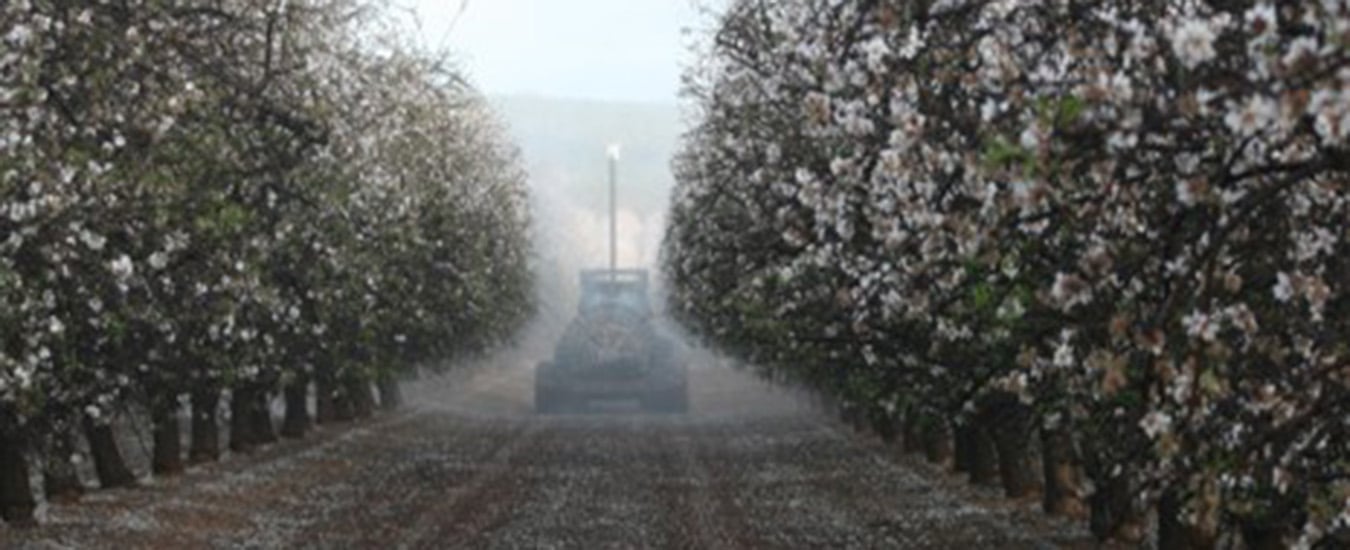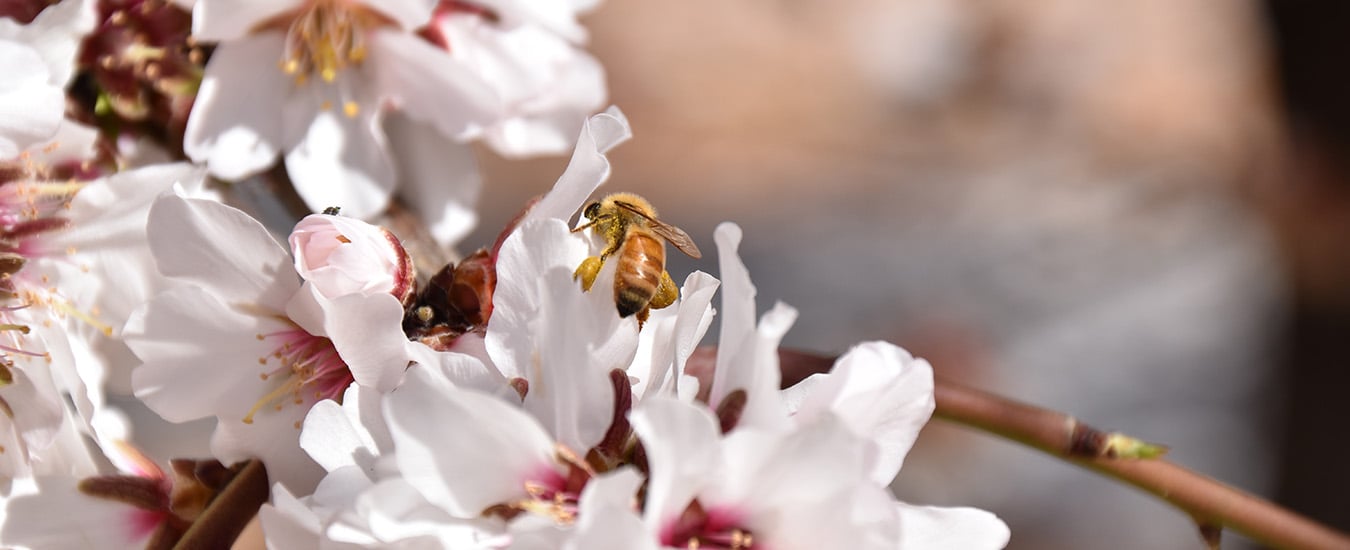The largest migration of livestock in Australia is upon us as almond bloom finishes and over 220,000 bee hives, some 6 trillion bees (give or take a few billion), are transported to “greener pastures.” In the case of the honey bee, however, “greener pastures” equates to the next mass flowering event of a crop like avocado, canola, citrus, lucerne, or native, nectar-producing tree like river red gum (Eucalyptus camaldulensis), yellow box (Eucalyptus melliodora) or another gumtree not burnt in the 2019-20 bushfires. Australia’s smallest livestock need us to communicate for their benefit on pest control activities given they fly to flowers upwards of two kilometres from their hive.

Honey bees and other insects pollinate nearly 2/3s of agricultural produce in Australia and do this best in environments free of pest control activities during pollination.
Even pest control agents such as fungicides, which are generally not toxic to adult bees, may have potentially harmful effects when brought back to the hive on pollen or nectar and fed to juvenile bees. AgriFutures has published new factsheets on fungicides and bees in almonds, canola, apple and pear authored by Drs. Katja Hogendoorn and Jay Iwasaki from the University of Adelaide.
Fungicides can play a vital role in protecting plants against diseases. However, fungicides should only be used when necessary. Reducing fungicide use lessens their impacts on the environment, human and pollinator health, and the chance that diseases become resistant to fungicides. This will also reduce the cost of using fungicides unnecessarily. Ideally, when honey bees are contracted into pollination the grower will not spray any pesticide on the crop, especially not insecticides as bees are insects. If a pesticide such as a fungicide must be sprayed, there are best practices to follow to minimise harm to honey bees.
Honey bee best management practices for Australian almonds
Growers and spray applicators are recommended by the Almond Board of Australia to follow Honey Bee Best Management Practices for Australian Almonds:
- Always read the label and follow directions for use.
- Discuss your pesticide plan with your beekeeper and agronomist well before the start of the season to select chemicals that are safe for bees while still achieving effective pest and disease control.
- Before bloom, avoid applying insecticides with extended residual toxicity or systemic insecticides.
- Establish clear lines of communication with all involved in pollination and spraying so that each party is informed in advance of this busy season.
- During bloom, do not use pesticides with cautions on the label that read “dangerous to bees”, “highly toxic to bees,” “toxic to bees,” “residual times” or “extended residual toxicity.” Residual toxicity to bees varies significantly between pesticides and pesticide products, and their impact can last anywhere from hours to a week, or more.
- During bloom, spray fungicides only if essential and only very late afternoon, dusk or during the night, when the bees aren’t active allowing time for the chemical application to dry. Do not spray so late that the fungicide does not have time to dry before bees begin foraging the next day. Avoid tank mixing insecticides with fungicides (unless mixing with Bt).

Fungicide spray application in an almond crop
- Thoroughly clean spray tanks to avoid remnant insecticide contaminating fungicide sprays.
- Surfactants (adjuvants) should not be added to fungicides during bloom, unless stated otherwise on the label.
- Advanced warning is mandatory for pesticide products with the statement “dangerous or toxic to bees” on the label. Give beekeepers at least 48 hours but more time is preferable. Bees can only be moved at night and under suitable environmental conditions.
- See the sections on “the flowering process” for guidelines on how to determine whether exposed pollen is present in flowers.
- Ensure bees have access to clean water and cover or remove water sources before spraying and replace with clean water immediately after chemical use.
- Do not spray hives directly with any pesticide. Ensure that the spray-rig driver turns off nozzles when near hives.
- Ensure bees are not foraging in the area to be sprayed and do not hit flying bees with spray applications as the weight of spray droplets on their wings will mean they can’t fly.
- Be sure to avoid pesticide application or spray drift to blooming weeds in or adjacent to the orchard when honey bees are present.
- Notify neighbours when bees will be in the orchard and provide your contact details so they can provide notice before intended sprays.
- After bloom, and once the hives have been removed, it is recommended to check the locations where the hives were kept for bees that may still be foraging.
- Before making insecticide applications outside of the pollination season register each spray event through the BeeConnected App to check for hives in the area and automatically alert beekeepers.
Video
Iron Talk: Insecticides and bee safety – AgPhD
Remember to keep all parties informed of agricultural sprays according to the communication chain agreed upon so that beekeepers are always aware of impending applications and spray operators are fully informed of the parameters regarding materials, timing, location, climate conditions and method of application.
Importantly, even if the pesticide label reads “not toxic to bees,” any spray application which hits a flying bee prevents the bee from flying because of the weight of spray droplets on their wings. This becomes incredibly important in winter flowering crops such as almonds where temperatures are quite cold through the day and every low wind, high temperature day is important to ensure successful pollination. If fungicides must be applied during bloom, for example, the grower or spray applicator should wait until no bees are flying near dusk or at night as temperatures drop and bees have returned to their hives for the day. This minimises fungicide spray onto bees actively flying, foraging on flowers and doing their job of pollination to ensure the grower has a viable harvest.
Fungicide spray application in any crop, if absolutely necessary, should occur near dusk or overnight at low temperatures when no bees are present on flowers to avoid changes in pollination behaviour and minimise bees bringing back fungicide to the hive which, when fed to juvenile bees could be potentially harmful. Worse yet, when fungicides on one crop mix with insecticides from another nearby crop and are combined inside a honey bee hive, the chemical combination increases the negative impact insecticides have on honey bees, known as a synergistic effect. Ideally, no spray should be applied when bees are actively foraging on a flowering crop to ensure hives are healthy and productive for the next pollination or honey production event.
Acknowledgements:
This article was peer-reviewed by Nadine Chapman, Michael holmes and Jay Iwasaki (University of Adelaide).


